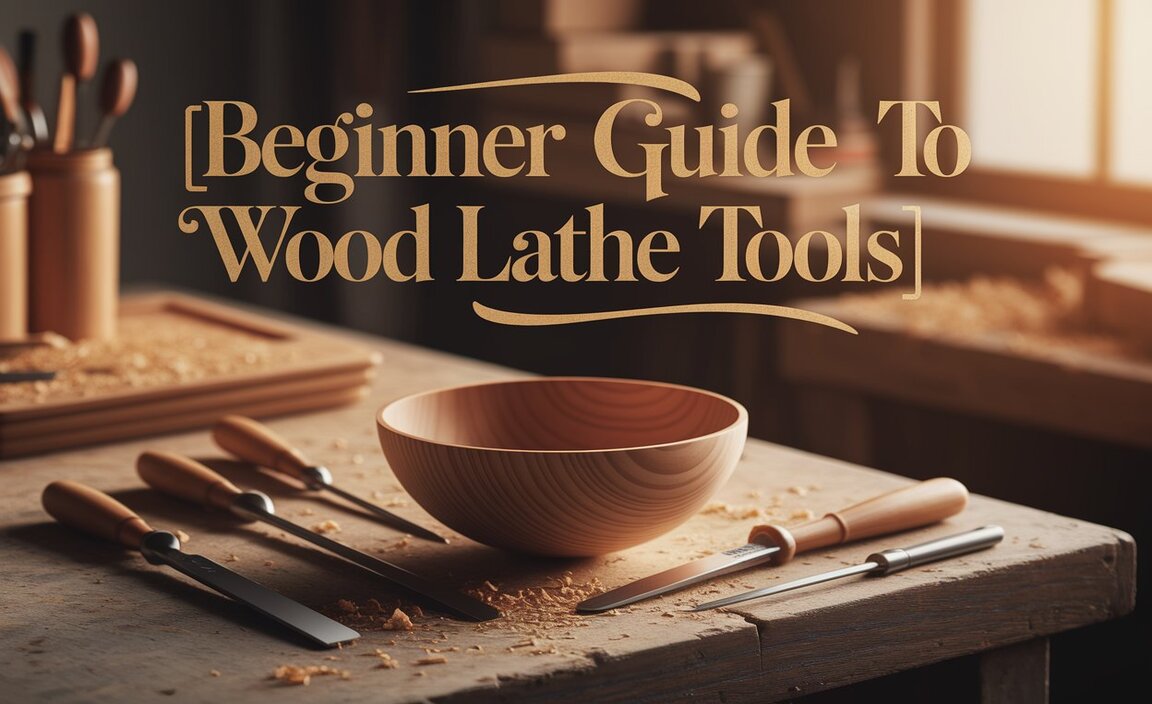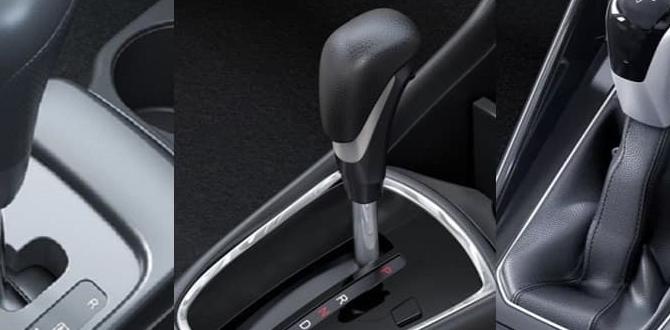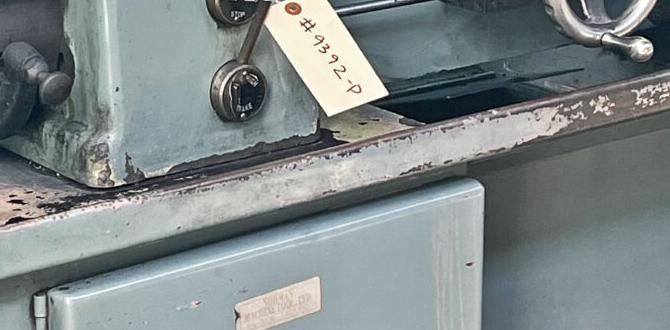Quick Summary
A parting tool for a lathe is crucial for cutting stock precisely to length or creating narrow grooves. This guide simplifies its use, covering tool selection, setup, safe operation, and common challenges, empowering beginners to achieve clean, accurate cuts with confidence.
The Parting Tool for Lathe: Your Essential Guide to Clean Cuts
Ever tried to cut a piece of metal or wood to a specific length on your lathe, only to have it wobble, break unevenly, or leave a messy edge? It’s a common frustration for beginners. But there’s a simple, effective tool designed just for this: the parting tool. Often called a cutoff tool, it’s your go-to for slicing through material cleanly and accurately. Don’t let its specialized look intimidate you; with a little understanding and practice, you’ll be making perfect cuts in no time. This guide will walk you through everything you need to know to master the parting tool.
What Exactly is a Parting Tool for a Lathe?
At its core, a parting tool is a specialized cutting bit for a lathe. Unlike general-purpose turning tools that shape the outside of a workpiece, a parting tool is designed to penetrate the material from the outside edge inwards, creating a groove or cutting the workpiece completely free from the stock.
Think of it like a very precise saw blade on your lathe. Its key feature is a narrow, deep blade, often with a slight relief angle on the sides to prevent it from binding in the cut. This design is essential because the tool is often working with a high chip load and needs to clear chips effectively while maintaining its integrity.
Why is a Parting Tool So Important for Beginners?
For those new to the lathe, controlling the material as you cut it free can be a real challenge. If you try to use a standard turning tool to cut something off, the workpiece often gets pushed around, flexes, or breaks off in a ragged fashion. This leads to:
Inaccurate lengths: Your finished pieces won’t be the size you intended.
Rough surfaces: The cut end will look unprofessional and may require extensive cleanup.
Material waste: If the cut is bad, you might have to discard the workpiece.
Safety hazards: A workpiece breaking free unexpectedly can be dangerous.
The parting tool, with its narrow kerf and strong blade, is engineered to overcome these issues. It makes achieving precise, clean cuts possible, boosting your confidence and the quality of your projects right from the start.
Understanding the Types of Parting Tools
Parting tools come in a few variations, each with its own advantages. Knowing these will help you choose the right one for your machine and materials.
1. Solid High-Speed Steel (HSS) Parting Tools
These are the classic parting tools, often found in beginner kits. They are made from a single piece of high-speed steel.
Pros: Affordable, easy to sharpen, good for a wide range of materials.
Cons: Can be prone to breaking if too much force is applied or if the workpiece flexes. The blade can be relatively thick compared to insert types.
2. Insert Parting Tools (Carbide Inserts)
These tools feature a holder with a slot where a replaceable carbide insert is mounted. The insert is the actual cutting edge.
Pros: Very strong and stable due to the robust holder. Carbide inserts are extremely hard and can handle higher speeds and tougher materials. If the insert breaks or wears out, you replace just the insert, not the whole tool. Offers a very thin kerf.
Cons: More expensive initially. Inserts themselves need to be replaced when worn. Sharpening is not an option for carbide inserts; they are replaced.
3. Spring-Tempered Steel Parting Tools
These are a subset of solid HSS tools but are made from spring steel, allowing for more flex.
Pros: Less likely to snap than standard HSS tools, offering a bit more forgiveness.
Cons: May be slightly less rigid than solid HSS or insert types, potentially leading to chatter on deep cuts.
For beginners, a solid HSS parting tool is a great starting point. As you gain experience and work with tougher materials, you might consider upgrading to an insert type.
How to Choose the Right Parting Tool Size
The size of your parting tool is crucial. Here’s what to consider:
Blade Width (Kerf): This is the thickness of the cut the tool makes. Thinner is generally better as it wastes less material and requires less force. Common widths range from 0.030″ (0.7mm) to 0.125″ (3mm) or more.
Blade Depth: The tool must be long enough to cut through your workpiece without the tool holder hitting the lathe bed. Measure the maximum radius of the work you intend to part off and ensure your tool is at least that length, plus a little extra clearance.
Shank Size: This must match your lathe’s tool post. Common sizes are 1/2″ (12mm) or 5/8″ (16mm) square shanks.
Most beginner lathes are well-served by tools with a 1/2″ or 5/8″ shank and a blade width between 0.040″ and 0.060″ (around 1mm to 1.5mm).
Setting Up Your Parting Tool for Success
Proper setup is 50% of the battle when using a parting tool. Get this right, and your cutting experience will be infinitely smoother.
1. Tool Height Alignment
This is perhaps the single most critical step. Your parting tool must be set precisely to the center height of the lathe spindle.
Why it matters: If the tool is too high, it digs in with its top edge, creating a tearing action and increasing the risk of breaking the tool or workpiece. If it’s too low, it rubs or skips over the material, performing poorly.
How to check: Most tool posts have a way to adjust height. You can also use shims (thin strips of metal or cardboard) placed under the tool shank in the tool post to raise or lower it. Use your lathe’s center or a height gauge to find the exact spindle center.
2. Tool Angle (Relief)
Parting tools have a specific geometry. The cutting edge is straight across, but the sides have a slight “relief” angle.
Front Clearance: The face of the tool should be perpendicular to the workpiece.
Side Clearance: The sides of the blade are ground with a small angle (usually a few degrees) so they don’t rub against the walls of the cut.
Setting it: When mounted in the tool post, the cutting edge should be presented squarely to the face of the workpiece. The side clearance is ground into the tool itself. You typically don’t need to angle the tool in the tool post unless you’re dealing with very specific materials or geometries.
3. Tool Position and Stability
Clearance: Ensure the tool holder has enough clearance from the chuck, tailstock, and the workpiece itself. You need room to make the full cut without the tool hitting anything as it moves into the work.
Secure Clamping: The parting tool must be clamped very securely in the tool post. Any movement will lead to chatter, poor finish, and potential tool breakage.
Step-by-Step: How to Use a Parting Tool
Now that your tool is ready, let’s walk through the process of making a cut. Safety first! Always wear safety glasses. Ensure your workpiece is securely held in the chuck.
Step 1: Prepare Your Workpiece and Lathe
Secure the Stock: Ensure your workpiece is firmly gripped in the chuck. A long piece of stock protruding far from the chuck is more likely to vibrate and break. A smaller overhang is better when parting off.
Select Speed: Start with a moderate lathe speed. For parting, slower speeds are generally safer, especially for beginners. A good starting point might be around 300-600 RPM, depending on your material and lathe size. You can consult resources like the Metals Handbook for recommended cutting speeds, but use them as a guideline and be prepared to adjust. You can find guidance on cutting speeds at resources like CMW University’s Machining Speeds & Feeds.
Set Tool Height: Double-check that your parting tool is perfectly on the center line.
Step 2: Position the Tool and Take a Test Cut (Optional but Recommended)
Advance the Tool: Bring the parting tool to the face of the workpiece. Carefully advance it until the very edge of the cutting blade just kisses the surface of the material.
Retract Slightly: Move the tool back a tiny amount.
Take a Shallow Pass: Turn on the lathe. Advance the parting tool just a very small amount (e.g., 0.010″ or a fraction of a millimeter) to create a shallow groove. This helps you verify the tool is cutting cleanly and that your speeds and feeds are appropriate.
Step 3: Make the Cut
Feed Rate: This is crucial for a good parting cut. You want a steady, consistent feed rate. Don’t force it, but don’t let it rub either. The tool should be cutting, not skipping or chattering.
For Metal: Use a slow to moderate handwheel feed or the slowest available power feed if your lathe has it. For brass or aluminum, you can often feed a bit faster. For steel, be more patient.
For Wood: You can usually feed faster than with metal. Listen to the sound; a smooth, hissing sound is good. A loud screech or vibration means your speed or feed is wrong, or the wood is splitting.
Step 4: Clear Chips and Lubricate (for Metal)
Chip Removal: As you cut, chips will pile up in the groove. Periodically, retract the tool slightly to allow chips to clear. For deeper cuts, you may need to retract the tool completely and clear the chips with a brush or air blast.
Lubrication: For metals, especially steel and aluminum, use a cutting fluid or lubricant on the tool and workpiece. This helps cool the cutting edge, lubricate the cut, and improve chip flow, reducing friction and wear on the tool.
Step 5: Completing the Cut
Watch for the Break: As the tool gets closer to cutting the piece free, the workpiece will start to flex. Be prepared!
Support the Workpiece: Once the cut is nearly complete and the piece is about to detach, try to support it with your hand (carefully, with gloves if appropriate) or a piece of wood. This prevents it from falling and potentially damaging the lathe or yourself.
Avoid Binding: If the workpiece starts to bind the tool as it’s about to break free, stop the lathe immediately. You might need to carefully widen the groove slightly or apply more consistent feed.
Step 6: Inspect Your Work
Examine the Cut: Once the piece is parted, check the cut surface. It should be relatively clean.
Chamfer Edges: You may want to lightly chamfer (round over) the edges of the cut on both the leftover stock and the parted piece to remove any sharp corners.
Troubleshooting Common Parting Tool Problems
Even with careful setup, you might encounter issues. Here’s how to fix them:
| Problem | Possible Causes | Solutions |
| :————————— | :———————————————————————————————— | :————————————————————————————————————————————————————————————————————- |
| Tool Breaking | Tool height incorrect; Too much feed rate; Workpiece flex; Dull tool; Insufficient clearance. | Re-set tool height to dead center; Slow down feed rate; Support workpiece; Sharpen/replace tool; Ensure tool holder has clearance; Use thinner parting blade if possible; Use lighter cuts. |
| Chatter / Vibration | Loose tool; Workpiece not secure; Incorrect speed or feed; Tool height off; Dull tool; Too thin stock. | Tighten tool in post; Secure workpiece firmly; Adjust speed and feed (often slower speed, faster feed can help); Re-set tool height; Sharpen/replace tool; Ensure adequate stock overhang for rigidity. |
| Messy/Ragged Cut | Dull tool; Too high feed rate; Incorrect speed; Workpiece flex; Side clearance issues. | Sharpen/replace tool; Slow down feed rate; Adjust speed; Support workpiece; Ensure tool isn’t rubbing on the sides of the cut (rare issue if tool is ground correctly). |
| Parting Too Soon/Late | Incorrect initial positioning; Inaccurate measurement. | Practice precise positioning of the tool before starting the cut; Use measuring tools accurately; Use a dial indicator if extreme precision is needed. |
| Part Binding or Sticking | Chips not clearing; Excessive feed rate; Warped workpiece; Insufficient side clearance. | Retract tool periodically to clear chips; Slow feed rate; Ensure workpiece is straight; Check tool for proper side relief grind (usually not an issue with commercial tools). |
Maintaining Your Parting Tool
Proper maintenance will extend the life of your parting tool and ensure consistent performance.
Sharpening a Solid HSS Parting Tool
For solid HSS tools, sharpening is essential.
Grind the Top Rake: The primary grind is usually done on the top surface of the cutting edge. You want to maintain a slight negative or neutral top rake for strength. This means the top surface that meets the chip should be flat or slope slightly away from the direction of cut.
Maintain Side Clearance: The relief angle on the sides is crucial. Without it, the tool will drag and bind. Be careful not to overgrind this, as it weakens the cutting edge.
Sharpening Stones: Use fine-grit grinding stones or diamond files. Always sharpen on the “leading” edge of the grind.
Safety: Wear eye protection and gloves when grinding.
National Tooling Association offers resources on tool maintenance that can be helpful.
Sharpening HSS Parting Tool Blades vs. Inserts
HSS Blades: These can be sharpened multiple times. You’ll typically grind the top face and sides.
Carbide Inserts: These are not sharpened. When they become dull or chippy, they are replaced entirely. This is why insert tools are more expensive upfront but can be more economical in the long run for high-volume work or tough materials.
Storage
Store your parting tools carefully to protect the delicate cutting edge. Avoid tossing them into a toolbox where they can bang against other tools. A dedicated holder or case is ideal.
Parting Tools in Woodworking vs. Metalworking
While the principle is the same, there are nuances between using a parting tool on a metal lathe versus a woodworking lathe.
Metal Lathes:
Materials: Steel, aluminum, brass, stainless steel.
Speeds: Generally lower RPMs.
Tools: More robust, often with carbide inserts for harder metals.
Lubrication: Cutting fluids are almost always used.
Force: Higher forces are involved; tool rigidity is paramount.
Woodworking Lathes:
Materials: Various woods.
Speeds: Can be much higher RPMs.
Tools: Often made of HSS, designed for wood’s softer nature.
Lubrication: Generally not needed, though some specialized finishes might be applied.
Force: Lower forces, but wood can split or catch.
The tools might look similar, but your approach to speed, feed, and tool geometry will differ significantly. Always use tools designed for the material you are working with.
Beyond Basic Parting: Grooving Tools
Parting tools are excellent for cutting shallow grooves, but for wider or deeper grooves, specialized “grooving tools” are often used. These have wider cutting heads designed to create specific groove widths without the risk of breaking. If you find yourself needing to cut a groove wider than about 1/8″ (3mm), you might start looking into these.
Safety First: Always Prioritize Safe Machining Practices
Working with lathes involves inherent risks. Always remember these safety tips:
Eye Protection: Always wear safety glasses or a face shield.
Secure Clothing: Wear snug-fitting clothing, and tie back long hair. Avoid gloves when operating the lathe unless absolutely necessary for handling hot stock, and then use extreme caution.
No Loose Jewelry: Remove rings, watches, and necklaces.
Know Your Machine: Understand how to use the emergency stop and how to quickly disengage power.
Stable Workpiece: Ensure your workpiece is always securely held.
Tool Inspection: Regularly check your tools for damage or wear.
Maintain a Clean Workspace: Keep your lathe and surrounding area clean and free of obstructions.
For more detailed safety information, consult your machine’s manual and resources from organizations like the Occupational Safety and Health Administration (OSHA).
Frequently Asked Questions About Parting Tools
Q1: What’s the difference between a parting tool and a cutoff tool?
A1: There is no significant difference. The terms “parting tool” and “cutoff tool” are used interchangeably in machining and woodworking to describe the same type of specialized lathe tool used for slicing workpieces.
Q2: Can I use a parting tool to face off the end of my workpiece?
A2: While you can* technically use a parting tool to remove a small amount of material from the face, it’s not its intended purpose. Its narrow blade isn’






